Addressing bias early













The ultimate goal of Anthro Magazine, Paly’s social activism publication, is to create a platform and forum for students to express their opinions and voices. Social activism is bringing issues into the spotlight to spread awareness and create change in society. On this platform, we will promote unity, diversity, and respect. As a publication, we aim to be inclusive but do not tolerate hate speech of the targeting of individuals. We hope to highlight issues that we see in our community, create a safe place to discuss these issues, and to make sure student voices are heard.
As 2022 comes to a close, we are excited to publish Volume 5 Issue 2 of Anthro Magazine.
This issue, we focused on local and campus activists in stories such as “5 questions with RISE” by Saanvi Garg and Minirva Villegas and “Boba Guys rises up” by Brennen Ho and Payton Anderson. We also gave an overview of Palo Alto activism with “Local activism round up.”
In light of the recent midterm elections, we highlighted candidates' position on the nearby train tracks in “Crossing into the future” by Evelyn Zhang, Kat Farrell, and Saanvi Garg, and covered controversial former candidate Ingrid Campos in “Addressing bias early” by Ash Mehta.
As always, Anthro aimed to spotlight student activists and student perspectives, which we did this issue in stories such as “Torn between identities” by Evelyn Zhang and Maya Mukherjee and “Cleaning our beaches” by Sandhya Krishnan.
Going forward, Anthro aims to incorporate more authentic student voices via guest writers and artists. Last issue, senior Trianne Hontiveros contributed a guest opinion, “An anti-melanin society,” and we would love to have similar pieces in the future. If you are interested in contributing to Anthro, please reach out. — MAYA MUKHERJEE and ASH MEHTA
The staff welcomes letters to the editors. We reserve the right to edit all submissions for length, grammar, potential libel, invasion of privacy and obscenity. Send all letters to anthromagazine.paly@gmail.com or to 50 Embarcadero Road, Palo Alto, CA 94301.
Anthro is printed by Folger Graphics in Hayward, California. The Palo Alto Parent Teacher Association mails Anthro to every student’s home. All Anthro work is available at anthromagazine.org.
Anthro, a social activism magazine published by students in Palo Alto High School Incubator class, is a designated limited open forum for student expression and discussion of issue of concern to its readership. Anthro is distributed to its readers and the student body at no cost.


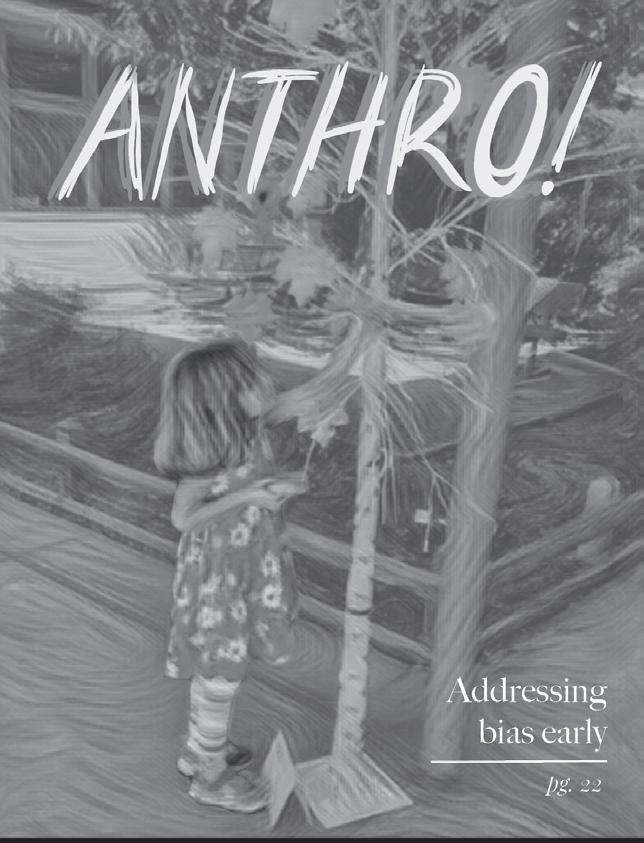
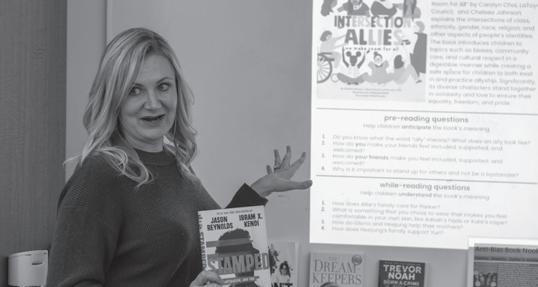



SLEEP OUT: On Nov. 17 and Nov. 18, Covenant House California hosted an event raising awareness about the youth homelessness crisis and also raised funds to help this organization provide young people with 24/7 support. Covenant House California is an organization that provides housing a supportive services to youth facing homelessness and trafficking in numerous cities across the United States, Latin America and Canada. In efforts to end youth homelessness, participants slept out their beds for one night to demonstrate the hardships people experiencing homelessness face according to the Covenant House California’s website.
PROTEST ANIMAL ABUSE: On Nov. 12, the Humane League, an organization dedicated to animal protection, hosted a protest in Irvine, California to bring awareness to animals who are trapped in factory farms. According to the Humane League’s website, protesters met at University of California--Irvine to ignite change with UCI's food service provider, Aramark. Aramark promised to end cruel animal abuse practices years ago, but has reportedly not yet fulfilled that promise.
CREATIVE ACTIVISM: On Nov. 12, the organizations Write Now and the Imaginists’ Guest House hosted an event in Santa Rosa filled with visual art and readings of poetry with roots in Native American, African, Asian, Latin American, Caribbean, and Muslim culture according to the Imaginists’ Guest House’s website.
TWO-SPIRIT IDENTITY: On Nov. 10, the California Institute of Integral Studies Public Program held an online event to spread awareness on two-spirit identity and cultural expression. The two-spirit identity is used by some Native Americans who identify with various cultural, spiritual and sexual gender identities. After surviving five centuries of colonial terminology and ideology, two-spirit people are now coming together to spread awareness about their identity across North America according to the California Institute of Integral Studies’s website.
At the Nutrition Services event on Oct. 10, Palo Alto Unified School District introduced several new vegan meal options for PAUSD cafeterias, despite the original initiative being scaled back.
In April, PAUSD piloted plant-based and vegan meals in response to a petition, led by students including Palo Alto High School senior Morgan Greenlaw. About 7% of meals served last year were vegan, according to PAUSD Food Services Director Alva Spence.
Greenlaw detailed her experience at the Nutrition Services sampling event in October.
“They [the event] had samples of all the new meals that they’re considering bringing in this school year,” she said. “And
so there were around like 11-ish new meals and like half of them were either vegetarian or vegan.”
Although new meals are being introduced, these meals add to the workload for the food staff, requiring more time and effort.
“Student Nutrition Services has added more scratch cooked entrees vegan, vegetarian and meat this year,” Spence said. “These meals do require more time to prepare as we are utilizing fresh products/ produce and have to combine them before service time to keep the product quality as fresh as possible.”
Greenlaw said the plant-based meals have been well-received with the student body.
“I’ve tried several myself and I’ve really
One year in, how have vegan meals changed?Photos by DANIEL
As Boba Guys employees attempt to unionize, reporters sat down with an anonymous Boba Guys employee on Oct. 28.
What was your initial reaction to what happened at the Boba Guys in San Francisco?
I wasn’t surprised, basically, even before all of this happened. Specifically, the thing that people were most upset about was that they were changing opening and closing times ... that time was essential for us to get the store up and running and then also close and clean everything, so people were upset about that. And then they also were cutting hours and they didn’t really tell people that they were cutting hours, so that caused problems for a lot of people because it’s like, if you don’t get enough hours, then you don’t make enough money to live. How will you and your staff proceed?
Basically, half my store plans to leave, if not more. So, one thing is that, I know my co-workers are happy with attempting to unionize, but it’s also not worth it because we don’t want to be at this company, we don’t want to be with these people, we don’t like management and we just want to leave. What’s even more upsetting is the way that they handled the entire situation.
How does what the Boba Guys’ superiors did to the SF employees change how you view your employer, if at all?

Just the way that they responded, it’s upsetting. Also, Boba Guys has a Slack channel. And usually, if they posted it in Slack, everyone would have seen it. And people would actually be able to talk about it and respond. Because they didn’t post in Slack, they did an email through a group that half of the employees aren’t even part of. So it’s very clear that they’re just trying to hide all this and ignore it and try to not deal with it.
Do the employees of Boba Guys in Palo Alto plan to stand in support of the SF employees, and how?
Currently, we don’t have plans to go on strike. The majority of us just plan on quitting. And if they don’t have anybody to, because I know the ASM plan on leaving, we only have two shift leads. I plan on leaving, and you can’t run the store with one shift lead. We have eight team members. If they quit, there’s nobody to run the store.
enjoyed them,” she said. “And I’ve also talked to a lot of people who are pretty plant-based and also have a very flexible diet and they have all said that they really like how fresh and healthy the plant based options are.”
Greenlaw said the plant-based meals are beneficial for many reasons.

“The reason that I went vegan was for animal rights, but the reason that we decided to push for this [plant-based and vegan meals] was for sort of all of the above combined,” she said. “Everything: the environment, animals, human health, and people’s well-being.”
Text by EVELYN ZHANG and MAYA MUKHERJEE Photo by DANIEL GAREPIS-HOLLANDOver eight million tons of plastic are dumped in the ocean annually. About 1.25 million tons pollute on beaches all across the United States. To some this may seem like another environmental reach, but Palo Alto High School juniors Alessandra Chandler and Kali Ressi di Cervia, they knew they had to take action.
Growing up, Chandler had always visited beaches in Santa Cruz where she would spend the day with her family.
"I would always pick up trash on the ground that we saw." Chandler said."As I learned more about all the pollution in our
environment and the effects of this pollution in ecosystems I involved myself in environmental cleanups to help these ecosystems thrive without harmful things like plastic, glass bottles and other trash." Chandler said.
So, Chandler and Ressi di Cervia founded and led the Beach Clean-up Club at Paly.
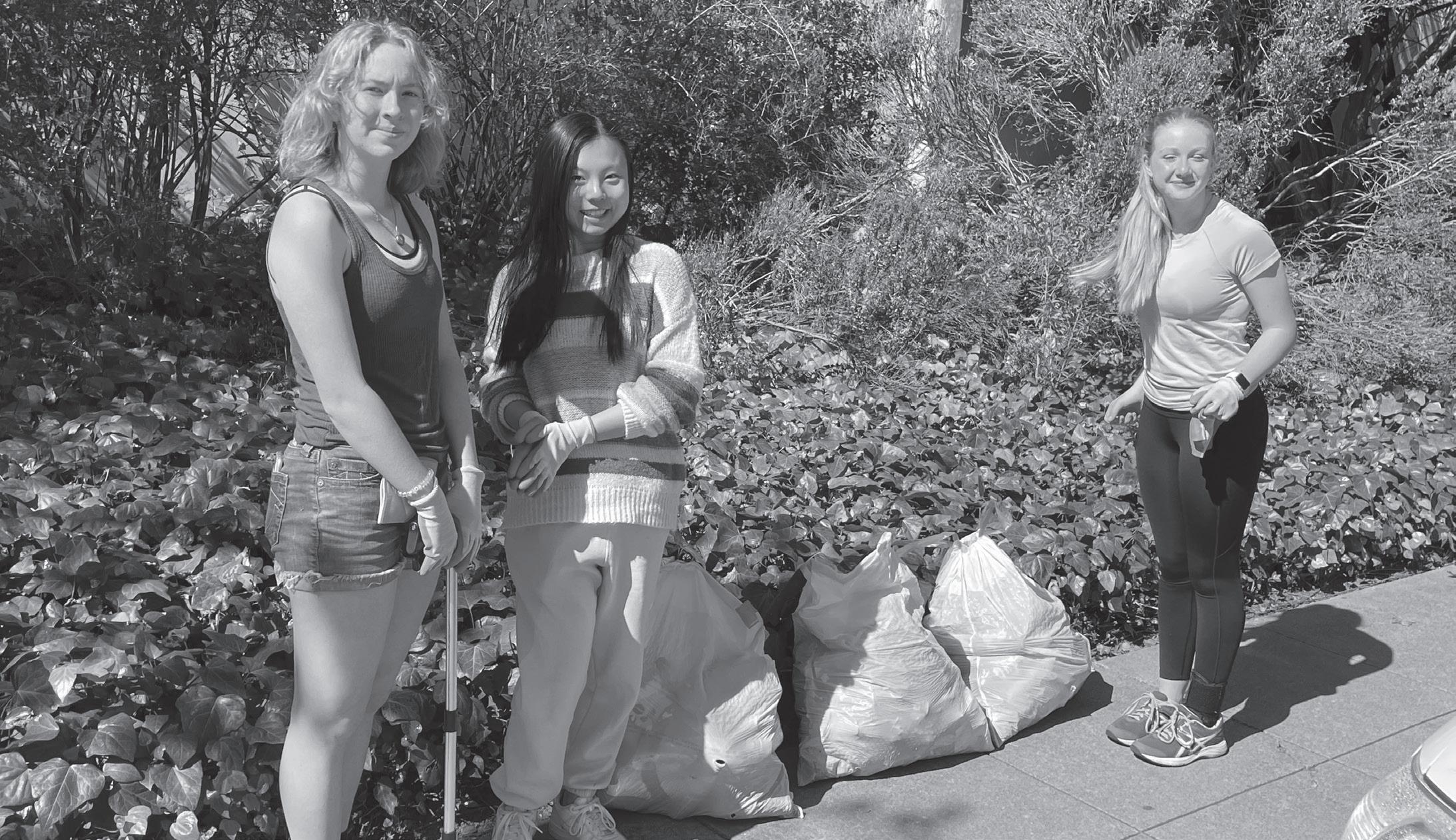
I wanted to create a club with other people who also care about the environment," Chandler said. “I really wanted to become more involved in Paly and I thought that creating a club would be a great way to get involved.”
After the launch of the club, Chandler shared the direction she and Ressi di Cervia wanted to guide the club in.
"Our goal for and the purpose of the beach clean-up club is to help the environment, inspire others to do what they can to help the environment, and spread aware ness of the pollution that occurs in our envi ronment," Chandler said.
After running the club for almost a year, the club has been able to go on clean-
Junior ALESSANDRA CHANDLER"I really love the environment and

items," Chandler said.
The co-presidents’ ultimate goal is to
“I really wanted to become more involved in Paly and I thought that creating a club would be a great way to get involved.”
—Beach Clean-Up Club members Hannah Huang, Alessandra Chandler, and Sarah Sheaffer clean up a nearby beach in spring of 2022. Photos courtesy of ALESSANDRA CHANDLER
get more people interested in helping the environment.
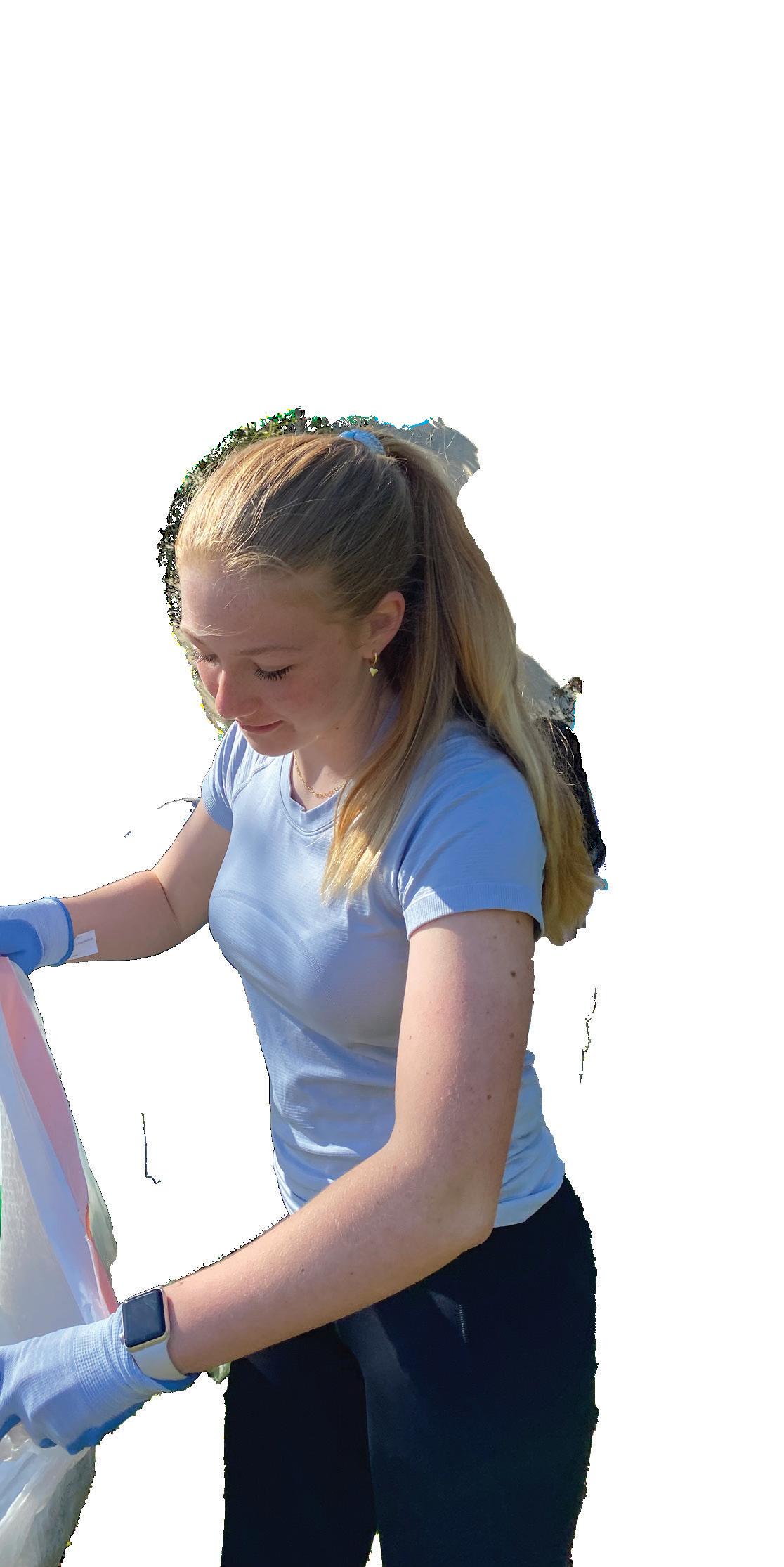
“As humans, we create so much pollution and I think that it is important to make sure that this pollution does not hurt any animals or their ecosystems,” Chandler said. “Right now many animals are in danger of going extinct because of the plastic that gets into their habitat.”
This year, the club has more plans on how to expand and get more involved with
RISE is a Palo Alto High School club devoted to promoting sexual safety and consent culture and led by juniors Bella Nguyen and Siri Schaefer Bastian. Anthro Magazine sat down with Nguyen for a Q&A about RISE.

s mission is to raise awareness and educate our community about consent culture, healthy relationships, and a safe campus environment. Our most recent and in-working project is Paly’s consent education. We have been working with Paly admin, the Wellness Center and One Love, a nonprofit organization. Creating engaging, impactful and meaningful workshops that will effectively bring awareness and educate students about consent and healthy relationships to the entire student body is our goal in this project.
We have been brainstorming ideas for possible events for Denim Day we could hold at Paly. We have the full intention of spreading awareness on its significance and encouraging students to show their support for the cause by wearing denim.
-
This club has been around longer than we’ve been at Paly. In past years, RISE has succeeded in raising awareness around sexual misconduct, acting as a source of support for students, and networking with outside organizations. Last year, we worked with Paly Admin and a non-profit organization called One Love to create a student lead consent and healthy relationships workshop and we are currently working on ways to improve it for this year.
We want to make sure that Paly is a place where all students feel safe and heard. RISE is looking to work with PAUSD middle schools to implement a consent education similar to that of Paly’s, as well as work with other high schools in the Bay Area to create a consent-conscious environment.


Pandemic relief student-run nonprofit adapts to a post-quarantine life

 Text by ASH MEHTA and LUCIANNA PERALTA Photos by ANNELISE BALENTINE Art by LAUREN WONG
Text by ASH MEHTA and LUCIANNA PERALTA Photos by ANNELISE BALENTINE Art by LAUREN WONG
In the depths of quarantine, a problem arose for both farmers and consumers. Local farms lost many of their main outlets — farmers markets, cafeterias, wholesale markets, and more. A question emerged: how would people get their fresh fruits?

From this emerged Giving Fruits, a Palo Alto nonprofit organization which connects local farmers with clients. Giving Fruits transfers produce from small Bay Area farms to consumers. The organization compiles advertisements for local farms on their website, where buyers can go and order produce. During quarantine, this was a good way of re motely connecting farm ers and buyers.
“Especially during the peak of the pandemic, it was a very important outlet for us,” said Marsha Habib, owner of lo cal family farm Oya Organics. “We had lost a lot of our oth er sales outlets that we had, prior to the pan demic.”
But as they emerge from the pandemic, many of these outlets are opening up again. Giving Fruits is adapting.
Giving Fruits president and Palo Alto High School senior Anjali Bhattacharya said that she got involved in Giving Fruits mostly because of a desire for in-person interaction. She said she’s grateful she chose to get involved.
Bhattacharya said that farmers are still in need of Giving Fruits, as they are still feeling the effects of the pandemic. She plans to continue the nonprofit’s efforts of connecting farms with customers, while also giving back profits to the Bay Area community.
“We’re gonna source and create some packages for … the South Palo Alto Women’s Shelter,” Bhattacharya said.
Habib works closely with Giving Fruits, and said that the group used to focus more on directly pandemic-impacted groups, and have been shifting focus in terms of who they donate to.
“Now, as we’re coming out of the pan-


demic they’re benefiting more charities and local shelters,” Habib said.
Bhattacharya said that Giving Fruits is trying to become more customer-centric, now that face-to-face interactions are more plausible.
“We form more relationships with them [customers],” Bhattacharya said. “Instead of just ‘fill out this form, we’ll put stuff [fruits] in your car.”
Maria De Greggorio, owner of a cherry farm was the person who contacted Habib to join Giving Fruits.
“She wanted to include other farm products,” said Habib, “And so we’re a diversified vegetable farm and also have access to strawberries, and no other farmers that have fruits. So she reached out to us. And at the time, we were also pivoting our sales outlets. And so we were like, Yeah, sure, we can definitely collaborate
Bhattacharya said that, though running this organization is challenging, it is worth it.
“It is hard work and a bunch of different things to do each week with communications with farms and city officials and things like that,” Bhattacharya said. “But overall, I’d say it’s a really fun experience and I’m really glad that I signed up for it.”
and help to bring up more farm products to giving fruits.”
“We had lost a lot of our other sales outlets that we had, prior to the pandemic.”
— MARSHA HABIB, owner of Oya Organics
 Text by CARISSA TSUI and
Text by CARISSA TSUI and
The outside portion of the heat pump is a boxy, softly-whirring thing. Sven Thesen points us to one side of it, then another, excitedly explaining the way it draws in heat from the outside air. His dog, also excited, barks eagerly, and the chickens penned next to the heat pump cluck in chorus.
The water pump water heater’s inside half, hidden inside a closet, looks just like any other: a plain tank with pipes running up and down, up and down.
Despite its understated appearance, an electric water heater is putting in more than its fair share of work and is just as effective as its more traditional gas counterpart..
According to The City of Palo Alto’s website, Palo Alto’s goal is to get 80% less CO2 emissions than the 1990s, meaning all energy must come from wind, solar, hydro, and other green sources to achieve carbon neutral energy production.
The website also states that water heating contributes more greenhouse gas emissions than anything else in Palo Alto homes, with 90% having gas-powered water heaters and a quarter of home energy use being from water heating.
Although the norm is to go with the gas-powered heater, there are many benefits with electric heat pump water heaters
(HPWH).
With fewer health and safety risks than gas water heaters there is a reduced risk of backdrafting.
Not only is the cost of an electric water heater lower than gas-powered heaters if homes have a rooftop PV system, but its complying with Palo Alto’s 100% carbon neutral electricity goal, with zero carbon footprint.
Additionally, the City of Palo Alto provides great incentives for those who switch over to water heaters.
A rebate of up to $2,300 is currently offered both for those who make the switch with a City contractor and those that do it independently.
According to Sherry Listgarten, a blogger for A New Shade of Green on Palo Alto Online, electric water heaters are highly recommended.
“They’re just giving money away for these water heaters,” Listgarten said.
The switch over from traditional to electric water heaters will soon become even easier.
According to City Sustainability Manager Christine Luong, the city is tak-
ing great steps to encourage this.
Early in October City Council approved a new Heat Pump Water Heater installation program for those interested in replacing their gas water heaters with electric heat pumps.
Through it, residents will be able to finance the change over at a heavily reduced cost, if there is any at all.
“Our goal is to replace 1,000 gas water heaters by the end of 2023,” Luong said. “We hope to learn from the program and see if we can replicate it with other gas appliances.”
Altering daily routines could be a good start to make a difference and achieve California’s goal for a zero carbon footprint.
“We are really strongly encouraging people to go to do this because it is long term and it will save you money and is so much better for the planet,” said Thesen.
Listgarten suggested changing of lights to LEDs and turning down thermostats. Teens can also go thrifting and biking around town. Additionally, when it comes to vacationing, local traveling has a lesser CO2 impact than flying.
“There’s so many things you can do,” Listgarten says, “So be informed. Communicate in ways that people can understand you and start small, don’t bite off more than you can chew. I think starting small is better than starting big in some ways.”
“It is long term and it will save you money and is so much better for the planet.”
— SVEN THESEN, chemical engineerChemical engineer and environmental activist Sven Thesen points out the various components of the heat pump. Thesen’s home is one of few in Palo Alto that has net zero energy efficiency. “To retrofit is always harder than to build new at the time of construction,” Thesen said. “[Still,] it’s a lot easier than it was a couple years ago.”
“Our goal is to replace 1,000 gas water heaters by the end of 2023.”
CHRISTINE LUONG , City Sustainability ManagerPhoto by LUCIANNA


Incubator, Paly’s suite of small publications, runs ads at rates ranging from $15 to $550. Small businesses, large companies, freelance workers, Paly students, anyone with something to advertise — contact us! Learn more at https://anthromagazine.org/ advertising.

For the first time in Palo Alto High School history, there’s a teacher in charge of student sup port systems.
Math teacher Deanna Chute is leading multitiered systems of support this year.

MTSS is a framework encompassing three levels, from universal support to highly individualized support for struggling students.
“None of this is about telling teachers what they should or shouldn’t do,” Chute said. “It’s about creating almost like a menu of options. If you find that you have students that are disengaged, or you have students who seem tired or students that are, you know, talking out of turn, or whatever the case may be … here are strat egies you can use.”
Chute said that, for the first time, MTSS strategy brainstorming has been staff-wide. She said that she’s trying to make MTSS structures that benefit both students and faculty.
“I just think it’s a little bit more front and center right now, because of the posi tion I have,” Chute said. “I told the staff back in the beginning of school, ‘If I’m not making your life easier, then I’m not doing my job.’”
Chute said one of her main focuses is going to be expanding Tier Two support. Tier One refers to strategies like mid-class breaks and lowered screen time, where as tier three encompasses 504s and IEPs, among other things.
Chute said that, though Tier Two exists and does have a few strategies such as the peer tutoring center, there needs to be more options between Tiers One and Three.
“I’m looking for more of a coherent system, more of a robust tier two,” Chute said. “I’m looking to properly identify kids
“I told the staff back in the beginning of school, ‘If I’m not making your life eas ier, then I’m not do inText by ASH MEHTA and KARRIE HUANG Photo courtesy of PALY VOICE MTSS: Systems of support coordinator and Paly math teacher Deanna Chute, pictured in a photo from Paly Voice. Text by EVELYN ZHANG, KAT FARRELL and SAANVI GARG by DANIEL GAREPIS-HOLLAND
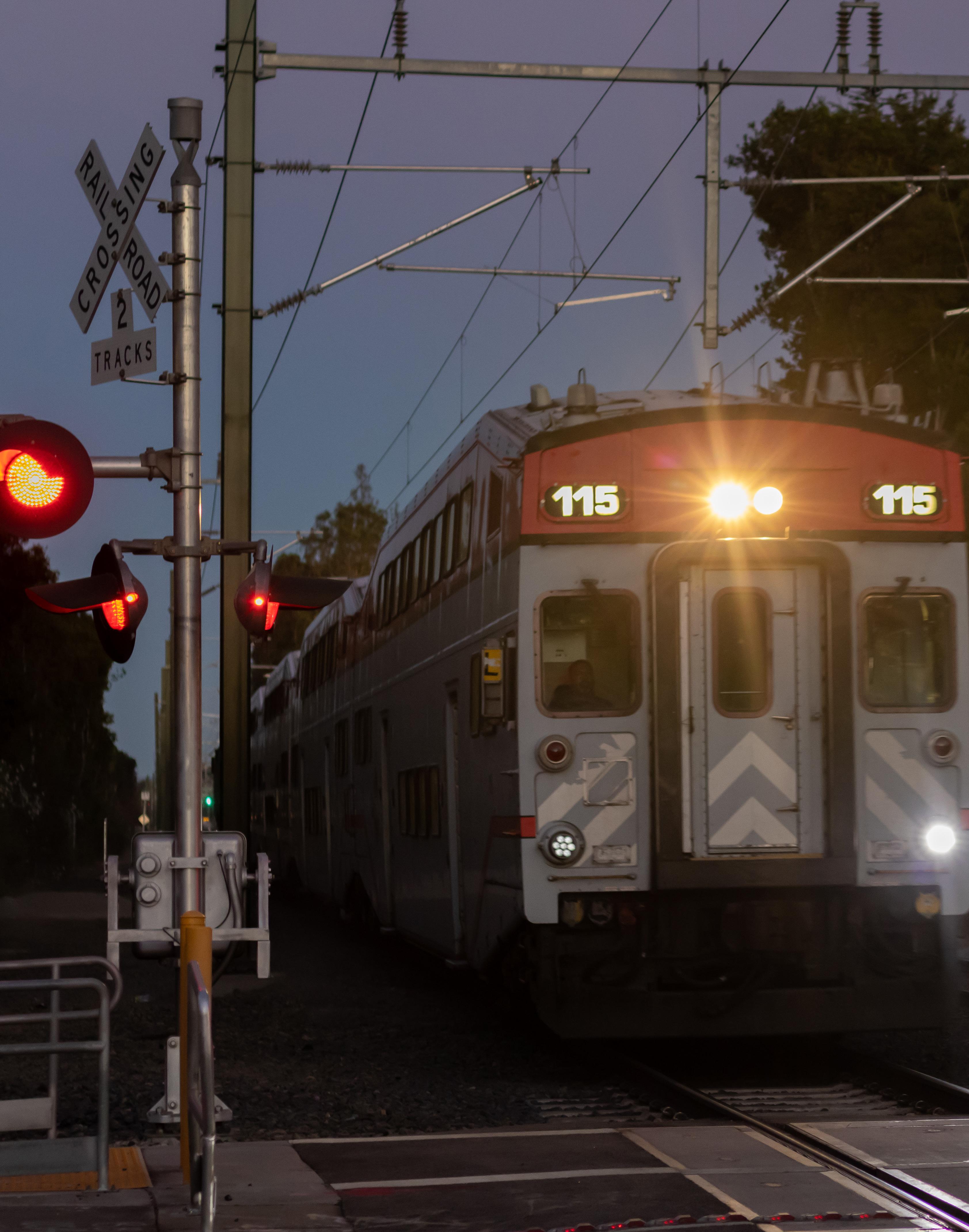 Photo
Photo
Does a new city council now mean a plan for safe railroad crossings?
According to Connecting Palo Alto, a community-based process overseen by the City of Palo Alto, between 2008 and 2020, there were eight fatalities at Palo Alto’s four grade crossings in which a train struck either a pedestrian or a vehicle.
Close calls with the Caltrain at the Churchill railroad crossing are close to home for many Palo Alto High School students.
Paly senior Paloma Raffle shares her scary experience at the Churchill crossing:

“The spacing was tight for cars to not get crushed,” Raffle said. “I was driving away from school and the light turned red, and I had to pull into the street to leave enough space for the blocker to come down for the train.”
The railroad creates much trouble for both vehicles and pedestrians because of the awkward intersection between the road and the tracks.
“Mainly, it just seems like a safety hazard, mostly because it’s often unclear when to move forward, and when the crossing arms come down, the train comes so quickly.”
During the city council elections, many candidates expressed their opinions concerning the possible remedies for this problem.
Now that the elections have passed and Veenker, Lauing and Lythcott-Haims emerge as winners, will the city council finally take action?
Palo Alto has four railroad crossings that are all in residential areas. Recently, the safety surrounding these intersections has become a hotly-contested topic in recent elections and within several Palo Alto neighborhoods.
There have been a few solutions on the table that have been considered for the past few years, including a hybrid underpass, a fully underground tunnel for cars, or a raised track of the train.
Some have gained a lot of support while others have been largely dismissed for their price or feasibility.
Ed Lauing, a recently elected member of the city council and current chair of the Planning and Transportation Commission in Palo Alto, stated that although ideally, the issue should be quickly resolved, the city council has yet to come up with a solution that is both feasible and nondisruptive.
For instance, one obstacle to building the proposed underpasses beneath the train intersections is that eminent domain would have to be applied. Eminent domain is the
right of the government to use private property for public use.
“We would have to buy and take down 84 homes entirely, and 42 others partially,” Lauing said. “So 130 people would lose their homes to do it. Now, I’m not going for that.”
To avoid eminent domain, Lauing says that the city has to collaborate with Caltrain and obtain vital information such as what technical specs they’re going to use.
“When we know if we have to put in two to four or two or four tracks, we can plan better, and maybe avoid all of the eminent domain,” he said.
Alex Comsa, a former candidate for Palo Alto City Council, raises concerns about the impact on not just neighborhoods near the railroad crossings, but also ones along Embarcadero that will be affected by the diverted traffic as a result of construction.
Although Comsa did not win city council, his views and concerns propose a different perspective for current city council members to consider.
Conversely, Julie Lythcott-Haims supports the viaduct because of its complete elimination of the intersection between the railroad tracks and the road.
“I’m interested in a solution that tries to anticipate future issues and concerns and term solution that will really be proud that we put in place for that reason,” she said. “I think the viaduct is the most visionary solution.”
Although the city council eliminated the viaduct as an option more than a year ago, Lythcott-Haims’s election to city council could mean a revitalization of this plan.
Due to Paly’s proximity to the Churchill crossing, the Palo Alto Unified School District is also a vocal participant in the discussions of potential solutions to this concern.
Lauing stresses the importance of taking small steps and prioritizing the safety of crossings, especially for ones with much civilian traffic like Paly around Churchill.
“Relative to safety, the most important part is to fix the pedestrian and bike crossings…the transportation department should have already done this,” he said.
Ultimately, the safety of Palo Alto residents is most important.
The initiative to solve this problem has constantly stalled despite continuous federal funding, but with a new combination of city council members, there is an opportunity — and a lot of pressure — to finally ensure the safety of railroad crossings.


From social media to advertisements, from dieting apps to fitness blogs, diet culture reaches Palo Alto students from all angles. School is oftentimes another way this is reinforced.
According to an opt-in, anonymous survey of 97 Palo Alto High School students conducted by Anthro Magazine, 74.7% of respondents said that they’d been exposed, in some way, to diet culture by teachers, administrators, and/or curriculum. Though most said the impact has been small to moderate, the impact is still there.
Diet culture, defined by the health online news site Very Well Fit as the belief that physical form is more important than well-being, can be reinforced by elements of school curriculum, such as Physical Education and Living Skills, and community.
places on fitness and diets specifically harms people.
Teaching about nutrition and fitness is necessary, according to the Centers for Disease Control and Prevention, in order to prevent illness, support physical health, and improve emotional well-being. However, this sort of education in schools can also fuel harmful ideas about bodies and food, according to Eating Disorder Foundation intern Heidemarie Streicher.
“We also see a lot of like attaching morality to foods,” Streicher said.
“So saying ‘foods are good, foods are bad,’ rather than just — we in the eating disorders sphere, we like to say — nourishing our bodies, right?”
— HEIDEMARIE STREICHER , Eating Disorder FoundationPhysical education can also be a source of problems for students, said Lauren O’Brien, a therapist with training in eating disorder treatment.
“I think there’s definitely a culture around eating more healthy foods, because it’s this idea that you don’t want to be obese or like you want to eat healthy,” Palo Alto High School senior Niklas Hagstroem said.
Diet culture is spread in many ways, such as social media. According to the New York Times, many teenagers struggle with comparing themselves to people they see on social media, and the emphasis social media
“We think about kids in elementary school in which kids get chosen to play certain games, because they appear more physically able, and in which kids sit off to the side and don’t get engaged in movement and are criticized for how they look or what their body looks like,” O’Brien said.
DuBose agreed that sports can damage self-esteem by playing into the culture of body shaming.
“It’s still considered normal in sports to weigh kids and body shame those who
“We also see a lot of like attaching morality to foods,” Streicher said.
“So saying ‘foods are good, foods are bad,’ rather than just — we in the eating disorders sphere, we like to say — nourishing our bodies, right?”
do not meet the “normal” expectations,” DuBose said.
Although diet culture is heavily embedded in our society, it tends to affect already people of color more than others, according to Streicher. Even though people of color are at higher risk for eating disorders, they are less likely to seek treatment due to stereotypes that portray eating disorders as a “heterosexual Caucasian female” problem, according to Psyschology Today.
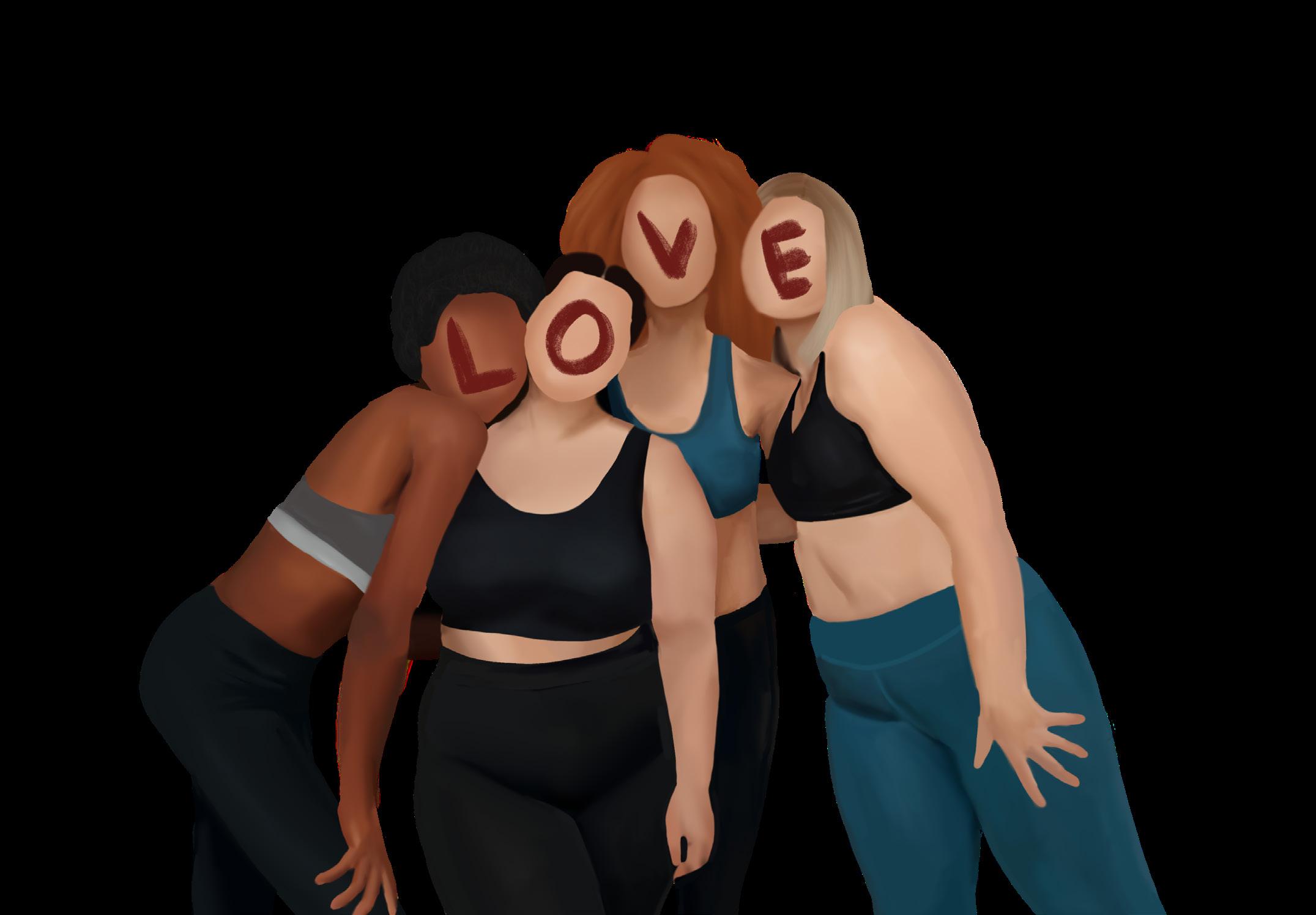
“Some people, some communities, their disordered eating behaviors are not addressed the same way as in other communities they are, which is a disparity,” Streicher said.
O’Brien said this inequality is due to how teaching about nutrition and fitness caters to certain people. According to a statement by Intensive Care Unit doctor and health specialist Milton Mills published in the Ithaca Times, the infor-
with their bodies,” Hagstroem said.
Senior Katie Firtch said that, even without diet-culture-trained counselors, Paly can provide more resources for people struggling with body image.
“The most pragmatic approach is to make sure that the current counselors we do have are connected with people who specialize in ED (eating disorders) if a student comes to them and needs that kind of help,” Firtch said.
Hagstroem said that Paly students should speak up more about body image-related bullying, when they see it occuring.
“The deceptive thing about it is that it’s usually friends on friends,” Hagstroem said. “It’s a lot harder for someone else to step in, because it’s sort of almost taken as a light hearted back and forth instead of direct attacks.”
Hagstroem said that there should be more education around diet culture and
cially,” he said.
Firtch said that education about diet culture may have the opposite effect. She said that people tend to rebel against the messaging the administration puts out.
“I guess messaging more just like here’s how you can treat yourself better, including ways that you can physically and mentally I guess, stay in touch with yourself,” Firtch said.
One way people can work against the effects of diet culture is to use different language when talking about body-related topics. Streicher said focusing on well-being is helpful.
“Instead of complimenting people’s bodies, compliment their clothing or their style, right?” Streicher said. “And moving away from just talking so much about weight and rather talking about wellness.”
DuBose also mentioned the importance of language when talking about food.
“Kids are very vulnerable to the language that is being used around them,” she said. “Schools should avoid using words like ‘bad foods’ and ‘good foods’ and should focus on teaching kids how to tune into their internal hunger cues, also
“It’s still considered normal in sports to weigh kids and body shame those who do not meet the “normal” expectations.”
NIKKI DUBOSE, eating disorder specialist
2/20-24: Scholastic Jouranlism Week
3/3: World Wildlife Day —#WorldWildlifeDay 3/8: International Women’s Day — #IWD202 Choose your own ______________________
Paly Media Arts Boosters is a 501(c)3 non-profit organization Tax ID# 46-2866404

Paly junior Hannah Jensen moved to Palo Alto from Vietnam earlier this year, and is balancing adapting to a new culture with keeping ties to her home countryadapting to being immersed in a new culture and community while keeping ties to her home country.
Jensen moved from Vietnam for more work and educational opportunities in America, such as being able to have a job at an earlier age and being able to choose more classes in school. Although she has managed to keep in touch with people from Vietnam, she said it has been difficult to do so.

“I’d say I still keep in contact with a lot of my friends from back home,” Jensen said. “It’s a little harder with the time difference and not being there, and I feel like if you move to a different country and you just stay connected to your old community, you’re not going to really be in the present here.” Adapting to cultural differences has also been something Jensen has had to navigate this year. She said social norms here contrast with ones in Vietnam; different things are acceptable to say and the way people interact with each other can also be more surface-level here.
However, she has been able to connect with other Vietnamese people in Palo Alto. At Paly’s orientation for new students, she met another Vietnamese student who she considers as her support system, and she has also bonded with Vietnamese people at her job.
Jensen said accepting the dual communities has helped her get more in touch with herself.
“Right now, there’s not one community,” she said. “I feel very connected to myself. I’m learning a lot more — you’re kind of breaking your own boundaries in a lot of ways.”
Austin Eng ‘24
Paly junior Austin Eng struggles with being culturally connected to both his Japanese and Chinese heritage, especially because of Bay Area stereotypes.

He is often perceived as fully Chinese and said that most people don’t acknowledge that he’s Japanese because they already have a preconceived notion of him. Eng attributes much of this treatment to his environment.
“In the San Francisco Bay Area especially, a large part or even majority of Asian Americans are of Chinese descent and that can lead to many people assuming I am just Chinese at first glance,” said Eng. Although he is often perceived as fully Chinese, Eng has struggled with being culturally connected to his Chinese identity.
“Growing up, I always felt like I ‘wasn’t Chinese enough’ because I didn’t go to Chinese school like my classmates.”
Additionally, Eng feels like he has more access to Japanese culture and spends more time with his Japanese extended family member sand and therefore is more comfortable with that half of his identity.
Despite the misconceptions that many people have about his identity and the struggle he encounters with being culturally connected to each part of his identity, Eng is appreciative of both parts of his identity.
“Although I feel more Japanese than I do Chinese, I spend time with both sides of my family,” Eng said. “Making sure that I keep in touch with both cultures is important, even if I am more involved in one of them.”

Paly senior Olivia Hau identifies as half French and half Chinese, and said she has continuously felt unaccepted into the Chinese community. However, she said she has been able to accept and love both sides of her identity.
Hau said although she speaks fluent Mandarin and is immersed in her father’s side of the family’s culture, other Chinese people at times do not recognize her Chinese identity.
“What especially hurts me is when Asian people, especially Chinese people, don’t validate my identity as an Asian person just because it’s taken me a while to accept and to embrace my Chinese culture,” Hau said.
Hau added that her experiences reflect the more difficult parts of being Asian, which gets overlooked due to being biracial.
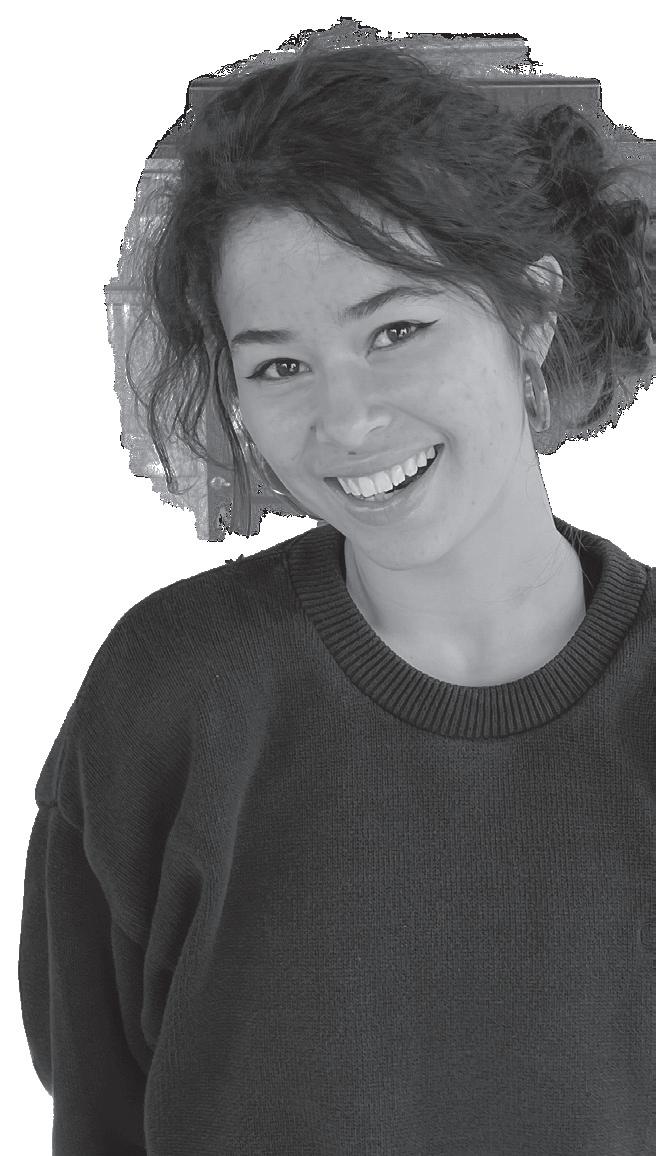
“I definitely experienced racism and oppression as an Asian person, but at the same time, I feel like those experiences are not validated, just because I am half white,” Hau said.

Attributing this divide to the stress people often place on labels, Hau said her dual identity often feels left out of conversations.
“Society, a lot of times, places pressure on putting labels on things,” Hau said. “It’s like, on standardized tests, you’ll see ‘Oh, are you Asian? Are you white?’ and sometimes there’ll be no option for ‘Are you multicultural and multiracial?’”
In Hau’s personal journey, she said she has been able to find peace with both her Chinese and French identities.
“I’ve also realized I don’t need to label myself,” Hau said. “And if I do need to label myself, I’m going to say that I’m both French and Chinese, and that I don’t need to pick one side because both are really key parts of my identity.”
Paly junior Caroline Jittipun has a Catholic Filipina mother and a Muslim Thai father, and said she feels the pressure to conform to one over the other.
“I feel like there’s a big difference in families with having to choose between a different religion once I’m older and having to experience both,” she said, “But then each family is kind of pushing you to be one certain religion.”
Jittipun said this pressure stems from her youth and has in part come from family members.

“I remember when I was little, my grandma took me to the mosque, and after we came back, me and my grandma were talking and she asked me, ‘ You’re gonna be Muslim when you’re older, right?’” Jittipun said. “And it put me in such an awkward position … I thought ‘Why can’t I be both?’”
Despite the divide Jittipun feels between the two religions, she said her parents are encouraging of the intersection between them.
“My parents are both supportive, they think I can be both once I’m older — I don’t need to choose between one,” Jittipun said. “We celebrate all of the holidays with both religions and it’s nice that way too.”
Jittipun said celebrating holidays from both religions is important to her, and if she has kids, she will raise them with both Muslim and Catholic traditions as well.
“I embrace both; I love to be both Catholic and Muslim,” she said. “I’m very proud of it, and having the holidays with my family is a big thing that we all celebrate.”
Olivia Hau Caroline Jittipun ‘24 Photos by MAYA MUKHERJEE
On Unity Day, Duveneck Elementary School students flocked around identity pin booths, listened to unity story read-alouds, wrote kindness notes, and engaged in other anti-bullying activities. Hilary McDaniel’s child development students helped host this event as part of the child development pathway’s broader anti-bias curriculum.
McDaniel uses the National Association for Education of Young Children framework to shape her curriculum. NAEYC, a nonprofit organization of 60,000 early childhood educators, defines anti-bias education as “support[ing] children’s development of a confident sense of identity without needing to feel superior to others.”
McDaniel’s students both learn child development and apply that learning to
their teacher-assistant positions at Duveneck.
“This [framework] really is geared for preschool students,” McDaniel said. “But I haven’t found something that’s really of the same caliber for elementary. And I do feel like maybe a lot of these elementary school students didn’t get this in their preschool.”
McDaniel said that anti-bias education is important because the human brain naturally forms biases, and schools must do their best to counteract that. Right now, a wave of legislation is being passed across the nation against anti-bias, anti-racist, and LGBTQ+ education.
“If you’re not explicit with them, then it can lead to stereotyping and prejudice and discrimination,” McDaniel said. “And so it’s really a whole lot better if we just start early and don’t make it so taboo.”
Pacific Standard, an online magazine focused on climate change and justice reporting, writes that bias impacts children very young. “Several studies have found
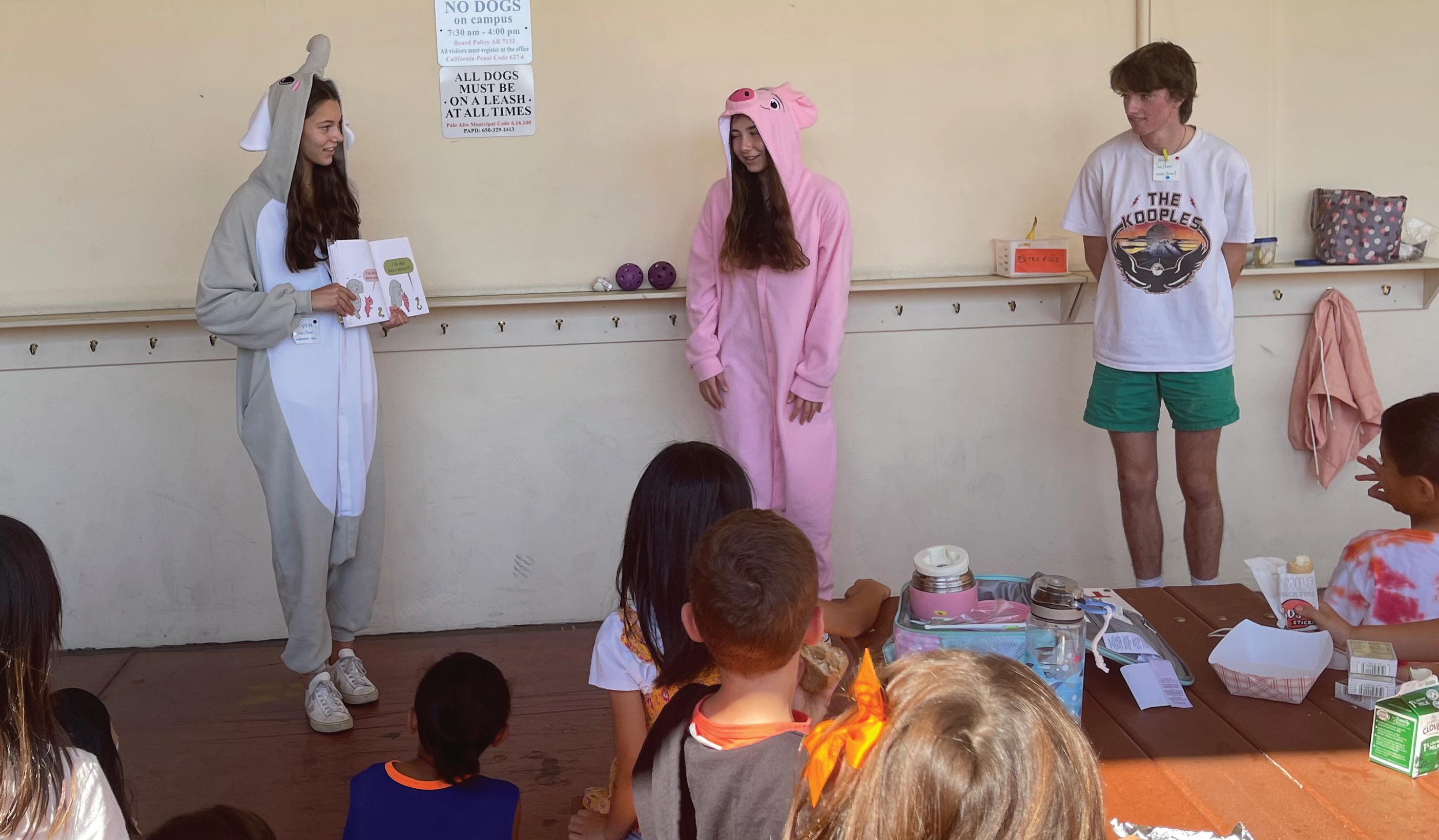
hatred of outsiders kicks in around age six, while others report it can be traced all the way back to infancy,” it writes, citing studies published in the National Library of Medicine.
Former Palo Alto Unified School Board candidate and self-proclaimed parental rights advocate Ingrid Campos has a different perspective on the issue.
Campos has two children in the PAUSD system. She said her children did not know what racism was until they were in school.
“I’m not sure what the purpose of teaching this kind of specific education, focusing on this specific topic, is really doing,” Campos said. “Everyone is assuming that there is racism and bias. … They’re innocent children, they don’t know about it yet.”
Campos said that she thinks some anti-racist and anti-bias education focuses too much on hate.
“We’re going down the wrong road, to focus on the haters, the one in 100 haters out there, and then put that into a les
Child development program implements anti-bias education at local elementary schools
“It’s really a whole lot better if we just start early and don’t make it [anti-bias] so taboo.”
— Child development teacher HILARY MCDANIELText by ASH MEHTA Photos by HILARY MCDANIEL and DANIEL GAREPIS-HOLLAND
son plan and say, this is how the world is,” Campos said. “I think there is a problem with that.”
Campos advocates another way of teaching justice.
“The foundation that was set for me was love your neighbor, love the people you’re with,” Campos said. “We never ever focused on skin color. Or whatever potential gender issues, we focused on being the best human being that we could possibly be based on the foundation of what we are.”
In terms of the justice and diversity components, McDaniel said that childrens’ brains are naturally attuned to concepts of “right” and “wrong,” so teaching them the concept of justice comes easily. Justice is one of the four tenets of McDaniel’s anti-bias framework.
“They [elementary school children] actually are very capable of having deep conversations about what is fair,” McDaniel said. “There are different books that talk about the concepts of equity versus equality and you’d be surprised how early on they can actually understand.”
McDaniel also promotes diversity in the classroom. She does an activity with her child development students where they analyze children’s books from before and after 2010 to examine the differences in representation between the two. Students counted the number of white children, children of color, and animals. The students found that there was more representation of animals in children’s books than people of color, pre-2010.
Anthro Magazine also spoke with child development students to hear their thoughts.
Senior and child development student Ryan Hudacek said that anti-bias education gives children confidence in their identity.
“Anti-bias education is important because it teaches children to have self confidence, use accurate language for diversity, recognize unfairness and understand that it hurts people, and learn to act against prejudice,” Hudacek said.
Harvey Vostrejs, another child development student and Paly senior, also advocates the importance of anti-bias education.
“I think it helps teach kids there are people other than you in the world,
people that aren’t like you, and they are just as human and just as deserving of respect,” Vostrejs said.
Vostrejs said that anti-bias education should consist of both representation and overt education.
“Even if it’s hard to discuss and difficult to talk about, it’s something that does need to be addressed,” Vostrejs said. “If they know about it, they can take actions to prevent doing that themselves. And, you know, speak up when they see wrong being done.”
Hudacek said that she’s applied what she’s learned in her child development class to her work at Duveneck.
“I have implemented anti-bias education in my work at Duveneck through casual conversations with 4th graders at lunch,” Hudacek said. “I engage in conversations with them and ask them questions like why they think a specific stereotype is true.”

Though Vostrejs said they haven’t outright used any of their anti-bias training yet, they have been helping kids out in other ways that incorporate anti-bias.
“I’m working with a student [who] … is clearly neurodivergent,” Vostrejs said. “I’m doing my best to help him, you know, kind of navigate the world in ways that I wish someone would help me.”
Vostrejs said that one room for growth in the anti-bias education curriculum is the section on neurodivergence, specifically autism. Vostrejs said the textbook portrays autism as a curable condition, though the general expert consensus is that autism cannot be cured, according to Healthline.
“It [the textbook] probably hasn’t been updated in a long time,” Vostrejs said. “It’s a neuro type, it’s not a disease, there’s no cure for it doesn’t need to be cured … And a lot of the resources out there are completely inaccurate.”
Recently, there’s been an increase in laws against anti-bias education, nationwide. Especially with the midterm elections, the fate of anti-bias education is at stake.
“That’s such a silly thing to politicize,” McDaniel said. “For any side, we want children to appreciate the rich world they live in and talk about differences that they are aware of.”
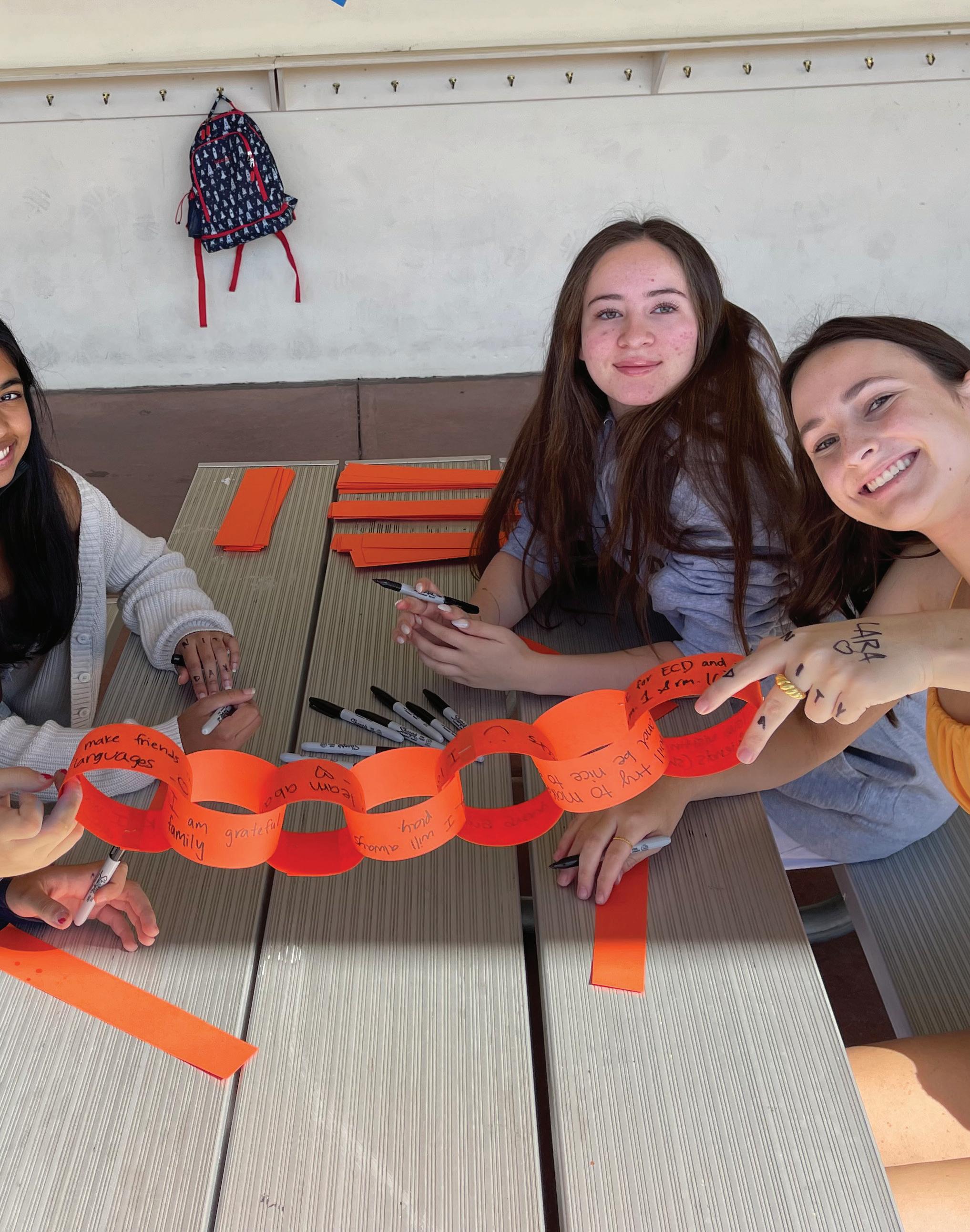
can. She designs her own personal “Best Friend” after Haru.
However, after selling her technology to a Chinese corporation, Virginia begins to suspect that “Best Friend” is being used to spy on Chinese citizens.
Afterword is a beautiful tale of getting over loss, as well as a stunning metaphor for the impact pedophilia can have on survivors for their whole lives.

The writing is compelling. Schuyler’s style is persistently beautiful, never crowded with overly descriptive prose, but understated and vivid.
promote messages of “the American Dream” and “money can’t buy happiness,” when that isn’t the reality. This book subverted that artfully.
The depiction of privacy in a digital age was also beautifully done.
The book also explored issues of the distinction between anti-Chinese racism and acknowledgment that the Chinese government is oppressive. Schuyler poses the question of “What is culture, and what is oppression?” and grapples with it insightfully.
Ahaunting portrait of grief, Nina Schuyler’s “Afterword” is a mustread for those who love dystopian, science fiction, complex plotlines with an emotional core. Though it doesn’t center around activism, it deals with themes such as sexism, privacy in a digital age, and anti-Chinese racism.
“Afterword” follows Virginia, an elderly woman living in San Francisco. As a teenager, Virginia was in love with her much-older math tutor, Haru. Though the tutor outwardly rejected her advances, he clearly viewed her in a semi-romantic way. Sixty years later, Virginia still considers Haru her one true love. Haru and Virginia’s relationship is left a bit up to the reader, though it seems creepy.
Haru died when Virginia was relatively young and, since his death, Virginia has been working to bring him back through artificial intelligence. Virginia invents the “Best Friend,” an AI that can converse just as a living person
Not only that, but this is one of the most uniquely paced books I’ve read in a long time. The pacing was never too slow or too fast, but also didn’t follow the standard, threeact formula for a modern novel.
It’s not edge-ofyour-seat thrilling, but rather, a steady kind of immersive.
The one flaw of this novel is its predictability. Had the writing not been so incredible, it wouldn’t have been hard to abandon the book, because I knew exactly how it’d end from the first few chapters.
This book portrayed the generational impacts of poverty incredibly. The portrayal of how poverty strained Virginia’s relationship with her mother was especially poignant. The quote “poverty has made her view life as a series of transactions” drove that point home. Too often, books almost romanticize poverty. They
One of “Afterword’s” main focuses is the experience of women in mathematics. Virginia was not allowed to excel in math, and was expected to live a life of a stay-athome mother, not learning math beyond the high school level. Haru was the only person who was willing to teach Virginia graduate-level math, and even then, Virginia had to keep his decision to tutor her a secret.
Schuyler didn’t put the women in STEM messaging at the forefront of the book, nor did she overtly state any of the activist themes.
Afterword is a beautiful book because it holds up in, while also representing the intersectional struggles and experiences Virginia faces over her lifetime.
Afterword is a gem. Every activist and every lover of emotional tales should add it to their 2023 reading list.
“Afterword is a gem. Every activist and every lover of emotional tales should add it to their 2023 reading list.”


Eric LaRocca’s horror novel, “Everything the Darkness Eats,” is a vibrant, immersive journey. Though a fun read, it relies more on shock factor than anything, and feels almost aimless. It tries to make an activism statement, but falls short.
“Everything The Darkness Eats” depicts a small town in Connecticut that’s haunted by a series of disappearances. It follows a few characters: Heart Crowley, the cult-ish, charismatic kidnapper; Ghost, the grieving, pained man; and Malik, the detective facing a barrage of homophobic hate crimes.
Heart discovers a secret artifact that gives him the power to compel others to his whim, which he uses to go on a killing spree, and then start luring people to his basement.
Ghost recently lost his wife, and ever since, a wraith has lived on his shoulder, feeding him messages of anxiety and selfhate.
Malik, the police officer following the disappearance cases gets a message saying “Die [f-slur].” Shortly after, someone breaks into his home and attempts to murder his husband, Brett.
Every page of this book was engaging, and I grew to love the characters. LaRocca managed to squeeze so many well-developed personas into so few pages without sacrificing the reader’s attachment to the characters.
That said, the plotlines don’t come together until the last few pages of the book and, as such, the book feels more like a rambling description of hatred, anger, and desire than a specific
story.
The Malik plotline, in particular, bothered me. LaRocca was clearly trying to make a statement on the homophobia that plagues many people, even today, but he missed the mark, and Malik and Brett’s subplot feels more like gratuitous violence than an impactful story.
The core issue of this book is the lack of chemistry between the characters. Yes, I cared about the characters personally, but that can only go so far. The characters did not seem to care about each other. Logically, yes, Malik loves Brett. Logically, Ghost loves Gemma. Logically, Heart and Ghost have a close yet conflicted relationship.
But I didn’t feel it emotionally.
This ties into the activism in the book. This plot could have made a statement about homophobia, had I actually sensed Malik’s love for Brett. It could have made a statement about moving on from loss, had I been able to tell how much Ghost loved Gemma.
That being said, “Everything The Darkness Eats” did have lots of queer representation, as well as representation of mental health, grief, disability, and Islamophobia.
LaRocca’s novel is a fun, engaging read. It’s short, and it’s a good way to spend a summer afternoon. It doesn’t make any points in a particularly powerful way, but the artfully crafted characters and the terrifying prose make it a good read if you’re bored.






GREAT BRITAIN: Climate activists are campaigning for Britain’s House of Lords (part of Parliament) to reject a recently revived public order bill. The bill would give police officers increased power to stop and search as well as potentially stop certain individuals from participating in protests at all. Also, some forms of “locking on” — sticking, locking or attaching oneself to immobile objects or to other people, a tactic often employed by climate protesters — would be outlawed. Protesters claim that the public order bill would infringe upon their rights to protest and are too far reaching.
Thousands of Armenians have turned out to protest the signing of a peace treaty with Azerbaijan in the city of Yerevan. They are protesting the concessions to Azerbaijan over the self-determination of the de facto autonomous region Karabakh. It has been overseen by Russian peacekeeping forces for the past few years. There is widespread disillusionment with the peace treaty since it will likely not favor Armenian interests.
Over 20 people in Uzbekistan’s autonomous Karakalpakstan area were killed by police in a protest deemed “largely peaceful” by the Human Rights Watch. Deadly “stun-grenades” were used. A new draft constitution that would prohibit Karakalpakstan from voting to secede spurred the protest. Despite the deaths, the protest successfully pressured the government into removing the parts of the constitution that restricted Karakalpakstan.




For a month, a wave of protests has swept Iran over the death of Mahsa Amini, who had been arrested for apparently not wearing her hijab in the right way. The government’s reaction has been intense with bullets fired into crowds of people. Thousands of protesters have been charged and Iran is even targeting children. Almost 200 activists have died. Still, a majority of Iran’s Parliament has signed an open letter demanding the protests be dealt with harshly. Universities have been a center of protest, and students have been staging sit-ins, fighting mandated gender segregation and more. Starting from Amini’s death, the activist movement in Iran has blossomed into a more general protest over the way the government’s theocracy is run.
Egypt cracks down on protests around the 2022 UN Climate Change Conference (COP27) by putting in place new restrictions on protests, arresting activists and forcing new cameras in all taxis. International civil rights groups have called the detainments arbitrary and demanded their release. There are newly established checkpoints where citizens’ social media is forcibly monitored for potential protest information. The portions of the summit — the “Green Zone” usually open to the public are now requiring pre-registration including passport numbers. Organizations and individuals from over 80 countries have signed a petition demanding the new restrictions be ended.



Palo Alto Unified School District
Palo Alto High School 50 Embarcadero Road
Palo Alto, CA 94301
Non-proft Org. U.S POSTAGE PAID Palo Alto, CA Permit #44


Incubator, Paly’s suite of small publications, runs ads at rates ranging from $15 to $550. Small businesses, large companies, freelance workers, Paly students, anyone with something to advertise — contact us!
Learn more at https://anthromagazine. org/advertising.